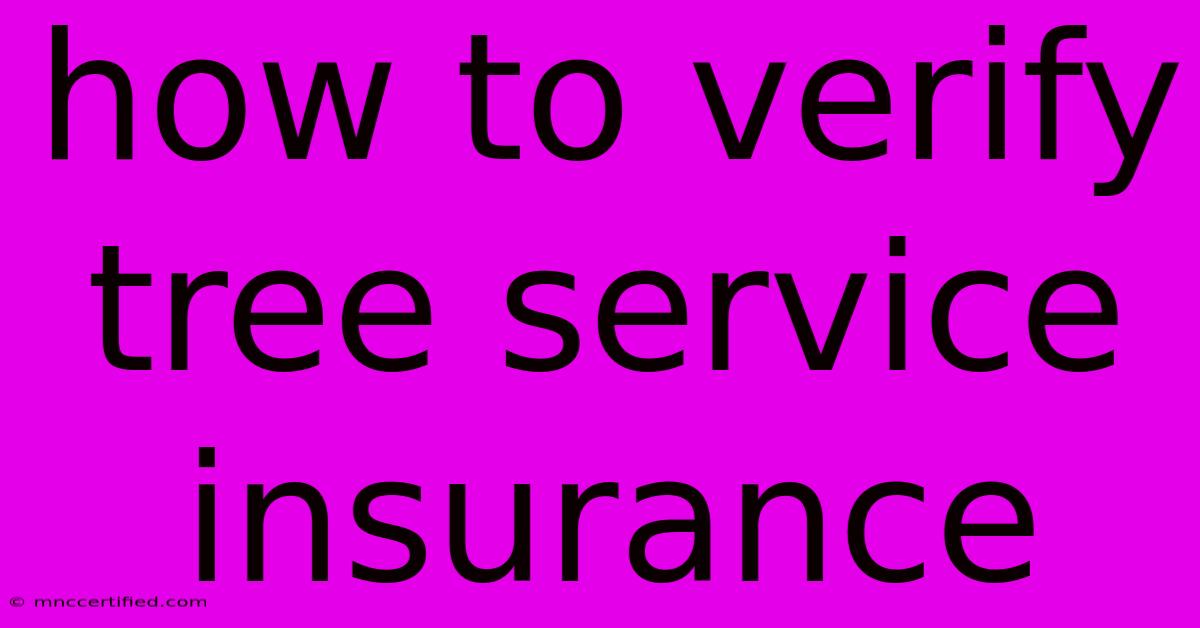How To Verify Tree Service Insurance

Table of Contents
How to Verify Tree Service Insurance: Ensuring Your Safety and Protection
Hiring a tree service can be a necessity, especially when dealing with hazardous or overgrown trees. But before you hand over any money, it's crucial to ensure the company is properly insured. Uninsured tree services can leave you liable for accidents, injuries, and property damage. This guide will walk you through the steps to effectively verify tree service insurance, safeguarding yourself and your property.
Why Verify Tree Service Insurance?
- Liability Coverage: If a tree service worker is injured on your property or causes damage, their insurance will cover the costs. Without it, you might be held responsible.
- Worker's Compensation: This insurance protects employees injured on the job. It covers medical expenses and lost wages, preventing potential lawsuits against you.
- Property Damage Coverage: If a tree falls on your house or car during removal, insurance will cover the repairs or replacement.
How to Verify Tree Service Insurance: A Step-by-Step Guide
-
Request Documentation: The first step is to simply ask the tree service for their insurance certificates. They should be able to provide these documents without hesitation.
-
Check for the Following:
- Type of Insurance: Confirm they have liability insurance, worker's compensation, and property damage coverage.
- Policy Limits: Make sure the limits on each policy are sufficient to cover potential expenses.
- Valid Dates: The policies should be current and not expired.
- State Licensing: In some states, tree services need specific licenses. Verify that the company is properly licensed.
-
Contact the Insurance Company: Don't rely solely on the provided certificates. Call the insurance company listed to verify the policy details. Ask for:
- Confirmation of coverage: Ensure the company is insured and the policies are active.
- Policy details: Ask about the limits and specific coverage details.
-
Additional Verification Methods:
- Online Databases: Some states have online databases where you can search for licensed tree services and their insurance information.
- Professional Associations: Check if the tree service belongs to any professional associations like the Tree Care Industry Association (TCIA). These associations often require members to maintain insurance.
Red Flags to Watch Out For:
- Reluctance to Provide Insurance Details: If the company is hesitant to share their insurance information, it's a red flag.
- Outdated or Expired Policies: Expired or near-expired policies indicate the company might be unreliable.
- Low Policy Limits: If the insurance policy limits are too low, you may not be fully protected.
- Lack of Licensing: If a state requires licensing for tree services, ensure the company is properly licensed.
Tips for Choosing a Reliable Tree Service:
- Get Multiple Quotes: Obtain quotes from different tree service companies to compare prices and insurance details.
- Read Reviews: Check online reviews from previous customers to assess the company's reputation and reliability.
- Ask for References: Ask the tree service for references from past clients.
By following these steps and staying vigilant, you can protect yourself from potential liability and financial hardship when hiring a tree service. Remember, verifying insurance is a crucial part of the hiring process, and it's worth taking the time to do it right.

Thank you for visiting our website wich cover about How To Verify Tree Service Insurance. We hope the information provided has been useful to you. Feel free to contact us if you have any questions or need further assistance. See you next time and dont miss to bookmark.
Featured Posts
-
Steelers Triumph New Receiver Seals Victory
Nov 11, 2024
-
La Portas Status Uncertain For Sunday Night Game
Nov 11, 2024
-
Lions Vs Texans Game Recap
Nov 11, 2024
-
Paddy Mc Guinness Cycles For Children In Need
Nov 11, 2024
-
Phoenix Insurance Group Harlingen Tx
Nov 11, 2024